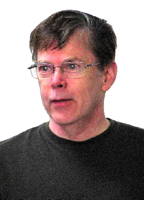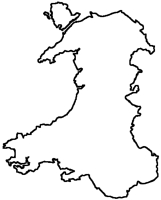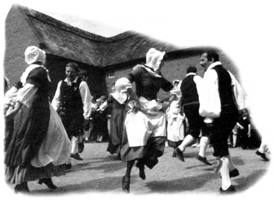
|
The Society of Folk Dance Historians (SFDH)
Welsh Folk Dance History
[
Home |
About |
Encyclopedia | CLICK AN IMAGE TO ENLARGE |

|
 Upon looking at the history of Wales, one wonders how the culture of language, music, dance, and other folk traditions survived. Obviously the Welsh were strong in keeping their language and culture alive through the 16th to 19th centuries despite the government and the clergy.
Upon looking at the history of Wales, one wonders how the culture of language, music, dance, and other folk traditions survived. Obviously the Welsh were strong in keeping their language and culture alive through the 16th to 19th centuries despite the government and the clergy.
In 1536 Wales was incorporated in England with the stipulation that no Welsh-speaking person should occupy any office within the King's dominions "unless he or she use and exercise the speech or language of English." Welsh is one of the oldest and still surviving languages spoken in Europe. Since the majority of Welsh-speakers could not communicate in English, there was little opportunity for them to hold any official office. It was not until 1942 with the Welsh Courts Act that some degree of recognition was given to the Welsh language. Finally, in 1993, the Welsh Language Act established the Welsh Language Board to "promote and facilitate the use of the Welsh language."
The church of the 18th and 19th centuries regarded dancing, singing (other than hymn singing), festivals, and traditional customs as sinful. The people had to conform to the pressures of the day to maintain good standing in the church. There were those, of course, who did resist and continued to dance and sing when they were sure they would not be found out. It's thanks to these brave souls that we still have some of the old Welsh dances and other Welsh culture.
William Jones (Llangadfan) and Edward Jones saw the great damage that was being done to the culture. They, along with other publishers such as Thompson, published collections of the dances that were being danced. John Playford had been publishing Welsh dances such as Lord of Caernarfon's Jig and Abergenny since the mid-17th century. Walsh was another publisher in the 18th century who published dances such as Meillionen (1726) and Evan's Delight (1718), choreographed by Nathaniel Kyneston of Trewylan. (Many folk dancers will recognize one of his other dances, such as, Softly and Good Tummas.) During this period, there was a lot of exchange and borrowing between the countries of the British Isles and Europe. Many Welsh dances went into the British/ English collections. They tended to keep their original Welsh names in translation to English. The dance Hoffedd ap Hywel became Powell's Fancy, for example.
 The Rev. Richard Warner, in A Walk Through Wales, in August 1797, has written of his observations of a genuine Welsh Ball in Pontneathvaughn, of his "complete inability to unravel the mazes of a Welsh dance. 'Tis true there is no great variety in the figures in them, but the few they perform are so complicated and long, that they render an apprenticeship to them necessary in an
Englishman."
The Rev. Richard Warner, in A Walk Through Wales, in August 1797, has written of his observations of a genuine Welsh Ball in Pontneathvaughn, of his "complete inability to unravel the mazes of a Welsh dance. 'Tis true there is no great variety in the figures in them, but the few they perform are so complicated and long, that they render an apprenticeship to them necessary in an
Englishman."
By the start of the 20th century, folk dancing contributed very little to Welsh culture. In the 1920s, Hugh Mellor and others started to take interest in the old dances. In 1918 he met Mrs. Gruffydd Richards from Llanover, who recalled dancing the Llanover Welsh Reel as a young woman. This was the first of the Welsh dances to be rescued. Another from the same area is Rhif Wyth.
The dances from Llangadfan were found in the National Library of Wales among the papers of Edward Jones. The dances Aly Grogan, Lumps of Pudding and The Roaring Hornpipe were noted in a letter he received from William Jones in 1790.
In the 1940s, Lois Blake and Gwynn Williams were important to the revival of the Welsh dancing tradition. Mrs. Blake is considered the driving force behind the revival of folk dancing in Wales. She travelled all over Wales researching and collecting dances. Almost single-handedly she rescued Welsh traditional dances from extinction.
The Nantgarw Dances were published in 1954. These dances were recollected by Margretta Thomas from her childhood in the 1890s. She often described the dances from her childhood to her daughter, Dr. Ceinwen Thomas, who had the foresight to note them down on paper. Dances from this area include Rali Twm Sion and Ceiliog y Rhedyn.
In the 1960s, Patrick Shuldham-Shaw reconstructed and interpreted many dances (e.g., Llanthony Abbey) and music from early Welsh manuscripts. He helped the growth of Welsh dance so much that he soon came to be known by his bardic name "Padrig Farfog."
From a greater understanding of the figures and music, Pat Shaw was soon choreographing dances in this style. Two of his most popular dances still danced in Wales today are Dawns y Pistyll and Ty Coch Caerdydd.
The British folk dance and folk song researcher Maude Karpeles has said that "the authenticity of folk dance lies not so much in origin, but to the amount of participation in the dance. If the people adopt a dance and translate it into their own medium, then, in the course of time, it can be considered part of their own tradition" (Blake 1972). Today many dances are being composed and finding themselves accepted into the Welsh dance culture.
Many dances with a Welsh name or "feel" to them came from the early collections, with the old import that, perhaps, they had nothing to do with Wales! By reviving and creating dances and with much research and practice, Welsh folk dancing has developed into a lively, visible, colorful, and living part of the Welsh culture. Alice Williams (1985) has said, "There is something of a different character that makes the Welsh dances differ from those of England, Scotland, and Ireland. It is very difficult to define this subtle difference, since it does not lie in the music alone, nor in a step, movement, or figure. Perhaps revealing it in our dancing is enough."
BIBLIOGRAPHY
- Blake, Lois (1965). Welsh Folk Dance and Costume (Llangollen: Gwynn).
- ——— (1972). Traditional Dance and Customs in Wales (Llangollen: Gwynn), p. 3.
- Lile, Emma (1999). A Step in Time: Folk Dancing in Wales (St. Fagans: Museum of Welsh Life).
- Mellor, Hugh (1935). Welsh Folk Dances: An Inquiry (London: Novello).
- Price, Glanville (1998). Encyclopedia of the Languages of Europe (London: Blackwell).
- Saer, D. Roy (1983-4). "Traditional Dance in Wales during the Eighteenth Century," Dawns, pp. 5–24.
- Thomas, Ceinwen H. (1973-4). "Nantgarw Dances (A Translation)," Dawns, pp. 37–53.
- Warner, Richard (1798). A Walk Through Wales, in August 1797 (Bath: Cruttwell), p. 114.
- Williams, Alice E. (1985). Llawlyfr Dawnsio Gwerin Cymru/A Welsh Folk Dancing Handbook (Caerdydd/Cardiff: Cymdeithas Ddawns Werin Cymru), p. 7.
DOCUMENTS
Printed in Folk Dancer Online,
Volume 43, Number 2, April 2012.
Used with permission.
This page © 2018 by Ron Houston.
Please do not copy any part of this page without including this copyright notice.
Please do not copy small portions out of context.
Please do not copy large portions without permission from Ron Houston.